Preparation of Bi2O3–YSZ and YSB–YSZ Composite Powders by a Microemulsion Method and Their Performance as Electrolytes in a Solid Oxide Fuel Cell
Abstract
:1. Introduction
2. Materials and Methods
2.1. Synthesis of Bi2O3 and Yttrium-Stabilized Bi2O3 (YSB) Powders
2.2. Preparation of Bi2O3–YSZ and YSB–YSZ Composite Powders and Their Bulks
2.3. Characterizations
3. Results and Discussion
3.1. Phase and Morphology of Bi2O3 and YSB Powders
3.2. Phase and Morphology of Bi2O3–YSZ and YSB–YSZ Composite Powders
3.3. Bi2O3–YSZ and YSB–YSZ Ceramics
3.3.1. Density
3.3.2. Phase Composition
3.3.3. Surface Morphology of Bi2O3–YSZ and YSB–YSZ Ceramics
3.3.4. Oxygen Vacancy of YSB–YSZ Ceramics
3.3.5. Electrical Properties
4. Conclusions
Author Contributions
Funding
Institutional Review Board Statement
Informed Consent Statement
Data Availability Statement
Acknowledgments
Conflicts of Interest
References
- Wang, F.; Lyu, Y.; Chu, D.; Jin, Z.; Zhang, G.; Wang, D. The electrolyte materials for SOFCs of low-intermediate temperature: Review. Mater. Sci. Technol. 2019, 35, 1551–1562. [Google Scholar] [CrossRef]
- Yu, D.; Wan, X.; Gu, B. Bi-objective optimization of biomass solid waste energy system with a solid oxide fuel cell. Chemosphere 2023, 323, 138182. [Google Scholar] [CrossRef] [PubMed]
- Lyu, Y.; Xie, J.; Wang, D.; Wang, J. Review of cell performance in solid oxide fuel cells. J. Mater. Sci. 2020, 55, 7184–7207. [Google Scholar] [CrossRef]
- Liu, T.; Zhang, X.; Wang, X.; Yu, J.; Li, L. A review of zirconia-based solid electrolytes. Ionics 2016, 22, 2249–2262. [Google Scholar] [CrossRef]
- Kulyk, V.; Duriagina, Z.; Kostryzhev, A.; Vasyliv, B.; Marenych, O. Effects of Sintering Temperature and Yttria Content on Microstructure, Phase Balance, Fracture Surface Morphology, and Strength of Yttria-Stabilized Zirconia. Appl. Sci. 2022, 12, 11617. [Google Scholar] [CrossRef]
- Kulyk, V.; Duriagina, Z.; Kostryzhev, A.; Vasyliv, B.; Vavrukh, V.; Marenych, O. The Effect of Yttria Content on Microstructure, Strength, and Fracture Behavior of Yttria-Stabilized Zirconia. Materials 2022, 15, 5212. [Google Scholar] [CrossRef]
- Zakaria, Z.; Abu Hassan, S.H.; Shaari, N.; Yahaya, A.Z.; Kar, Y.B. A review on recent status and challenges of yttria stabilized zirconia modification to lowering the temperature of solid oxide fuel cells operation. Int. J. Energy Res. 2019, 44, 631–650. [Google Scholar] [CrossRef]
- Xu, Q.; Guo, Z.; Xia, L.; He, Q.; Li, Z.; Bello, I.T.; Zheng, K.; Ni, M. A comprehensive review of solid oxide fuel cells operating on various promising alternative fuels. Energy Convers. Manag. 2022, 253, 115175. [Google Scholar] [CrossRef]
- Vinchhi, P.; Khandla, M.; Chaudhary, K.; Pati, R. Recent advances on electrolyte materials for SOFC: A review. Inorg. Chem. Commun. 2023, 152, 110724. [Google Scholar] [CrossRef]
- Li, Y.; Sun, H.; Song, J.; Zhang, Z.; Lan, H.; Tian, L.; Xie, K. Effect of Two-Step Sintering on the Mechanical and Electrical Properties of 5YSZ and 8YSZ Ceramics. Materials 2023, 16, 2019. [Google Scholar] [CrossRef]
- Raghvendra; Singh, P. Influence of Bi2O3 additive on the electrical conductivity of calcia stabilized zirconia solid electrolyte. J. Eur. Ceram. Soc. 2015, 35, 1485–1493. [Google Scholar] [CrossRef]
- Xiao, J.; Han, Q.; Yu, F.; Zhang, Y.; Wu, H.; Li, X.; Zeng, X.; Dong, P.; Zhang, Y.; Liu, J. Co-precipitation synthesis of alumina doped yttria stabilized zirconia. J. Alloys Compd. 2018, 731, 1080–1088. [Google Scholar] [CrossRef]
- Lim, Y.; Lee, H.; Park, J.; Kim, Y.-B. Low-temperature constrained sintering of YSZ electrolyte with Bi2O3 sintering sacrificial layer for anode-supported solid oxide fuel cells. Ceram. Int. 2021, 48, 9673–9680. [Google Scholar] [CrossRef]
- Dong, Y.; Liu, Z.; Qiu, G.; Pang, L.; Han, Y.; Yao, S.; Ding, J.; Wang, X. A limiting current oxygen sensor with 8YSZ solid electrolyte and (8YSZ)0.9(CeO2)0.1 dense diffusion barrier. J. Alloys Compd. 2021, 885, 160903. [Google Scholar] [CrossRef]
- Jeon, O.S.; Park, M.G.; Song, R.H.; Ryu, K.H.; Na, C.W.; Shul, Y.G.; Lee, J.G. Effects of Fe2O3 doping on structural and electrical properties of 8 mol% yttria-stabilized zirconia electrolyte for solid oxide fuel cells. J. Mater. Sci. Mater. Electron. 2022, 33, 3208–3214. [Google Scholar] [CrossRef]
- Xiong, J.; Jiao, C.; Han, M.; Yi, W.; Ma, J.; Yan, C.; Cai, W.; Cheng, H. Effect of Li2O additions upon the crystal structure, sinterability and electrical properties of yttria stabilized zirconia electrolyte. RSC Adv. 2016, 6, 106555–106562. [Google Scholar] [CrossRef]
- Alfeche, D.M.; Cervera, R.B. Highly conducting Sc and Y co-doped ZrO2 thin film solid electrolyte on a porous Ni/YSZ electrode prepared via simple drop-coating method. Ceram. Int. 2020, 46, 10561–10567. [Google Scholar] [CrossRef]
- Jiang, N.; Wachsman, E.D. Structural Stability and Conductivity of Phase-Stabilized Cubic Bismuth Oxides. J. Am. Ceram. Soc. 2004, 82, 3057–3064. [Google Scholar] [CrossRef]
- Wang, H.; Lei, Z.; Jiang, W.; Xu, X.; Jing, J.; Zheng, Z.; Yang, Z.; Peng, S. High-conductivity electrolyte with a low sintering temperature for solid oxide fuel cells. Int. J. Hydrogen Energy 2022, 47, 11279–11287. [Google Scholar] [CrossRef]
- Han, J.; Zhang, J.; Li, F.; Luan, J.; Jia, B. Low-temperature sintering and microstructure evolution of Bi2O3-doped YSZ. Ceram. Int. 2018, 44, 1026–1033. [Google Scholar] [CrossRef]
- Tian, Y.; Liu, S.; Zhang, X.; Xiao, S.; Sun, J.; Zhang, J.; Han, G. Controlled synthesis of Bi2O3–YSZ composite powders and their sintering behavior for high-performance electrolytes. Int. J. Appl. Ceram. Technol. 2022, 20, 1398–1407. [Google Scholar] [CrossRef]
- Tian, Y.; Jia, B.; Zhang, X.; Xiao, S.; Li, J.; Liu, S.; Min, G.; Han, G.; Li, A.; Zhang, J. Synthesis of γ-Bi2O3/YSZ composite powders using a facile precipitation method. Int. J. Appl. Ceram. Technol. 2022, 19, 2399–2405. [Google Scholar]
- Luan, J.; Zhang, J.; Yao, X.; Li, F.; Jia, B. Controlled synthesis and growth mechanism of Bi2O3/YSZ solid electrolyte materials. Ceram. Int. 2016, 42, 16262–16265. [Google Scholar] [CrossRef]
- Gandhi, A.C.; Lai, C.Y.; Wu, K.T.; Ramacharyulu, P.V.R.K.; Koli, V.B.; Cheng, C.L.; Ke, S.C.; Wu, S.Y. Phase transformation and room temperature stabilization of various Bi2O3 nano-polymorphs: Effect of oxygen-vacancy defects and reduced surface energy due to adsorbed carbon species. Nanoscale 2020, 12, 24119–24137. [Google Scholar] [CrossRef] [PubMed]
- Jung, H.J.; Chung, S.-Y. Absence of Distinctively High Grain-Boundary Impedance in Polycrystalline Cubic Bismuth Oxide. J. Korean Ceram. Soc. 2017, 54, 413–421. [Google Scholar] [CrossRef] [Green Version]
- Polat, Y. Effects of size on the phase stability and conductivity of double-doped δ-Bi2O3. J. Electroceramics 2018, 42, 89–97. [Google Scholar] [CrossRef]
- Battle, P.D.; Catlow, C.R.A.; Heap, J.W.; Moroney, L.M. Structural and dynamical studies of δ-Bi2O3 oxide ion conductors. J. Solid State Chem. 1986, 63, 8–15. [Google Scholar] [CrossRef]
- Tan, M.Y.; Tan, K.B.; Zainal, Z.; Khaw, C.C.; Chen, S.K. Subsolidus formation and impedance spectroscopy studies of materials in the (Bi2O3)1− x(Y2O3)x binary system. Ceram. Int. 2012, 38, 3403–3409. [Google Scholar] [CrossRef]
- Azad, A.M. Review: Bismuth oxide-based solid electrolytes for fuel cells. J. Mater. Sci. 1994, 29, 4135–4151. [Google Scholar] [CrossRef]
- Chen, R.; Luo, X.T.; Zhang, L.; Wang, D.; Li, C.X.; Li, C.J. Plasma-Sprayed High-Performance (Bi2O3)0.75(Y2O3)0.25 Electrolyte for Intermediate-Temperature Solid Oxide Fuel Cells (IT-SOFCs). J. Therm. Spray Technol. 2021, 30, 196–204. [Google Scholar] [CrossRef]
- Li, F.; Zhang, J.; Luan, J.; Liu, Y.; Han, J. Preparation of Bi2O3-DOPED NiO/YSZ anode materials for SOFCS. Surf. Rev. Lett. 2017, 24, 1750092. [Google Scholar] [CrossRef]
- Yan, Y.; Zhou, Z.; Cheng, Y.; Qiu, L.; Gao, C.; Zhou, J. Template-free fabrication of α- and β-Bi2O3 hollow spheres and their visible light photocatalytic activity for water purification. J. Alloys Compd. 2014, 605, 102–108. [Google Scholar] [CrossRef]
- Selvapandiyan, M.; Sathiyaraj, K. Synthesis, Preparation, Structural, Optical, Morphological and Elemental Analysis of Bismuth Oxides Nanoparticles. Silicon 2019, 12, 2309–2315. [Google Scholar] [CrossRef]
- Rodríguez-Rodríguez, A.A.; Martínez-Montemayor, S.; Leyva-Porras, C.C.; Longoria-Rodríguez, F.E.; Martínez-Guerra, E.; Sánchez-Domínguez, M. CoFe2O4-TiO2 Hybrid Nanomaterials: Synthesis Approaches Based on the Oil-in-Water Microemulsion Reaction Method. J. Nanomater. 2017, 2017, 1–15. [Google Scholar] [CrossRef] [Green Version]
- Peng, R.; Khan, M.A.; Wu, J.; Chen, Z. In Situ Dielectric Spectroscopy Monitoring of Silica Nanoparticle Synthesis in Cationic Water-in-Oil Microemulsions. Langmuir 2022, 38, 4121–4128. [Google Scholar] [CrossRef]
- Wei, J.; Su, B.; Liang, R.; Xing, H.; Bao, Z.; Yang, Y.; Ren, Q. Effect of the Ionic Liquid 1-Butyl-3-Methylimidazolium Tetrafluoroborate on the Properties of Water + Triton X-100 + Hexanol + Cyclohexane Microemulsions. J. Chem. Eng. Data 2012, 57, 1274–1278. [Google Scholar] [CrossRef]
- Liu, Q.; Wang, J.; Wu, H.; Zong, S.; Wang, N.; Wang, T.; Zhou, L.; Huang, X.; Hao, H. Structure and pseudo-ternary phase diagram of water/Triton X-100/1-pentanol/cyclohexane mi-croemulsion. J. Mol. Liq. 2022, 349, 118425. [Google Scholar] [CrossRef]
- Jiang, H.Y.; Liu, J.; Cheng, K.; Sun, W.; Lin, J. Enhanced Visible Light Photocatalysis of Bi2O3 upon Fluorination. J. Phys. Chem. C 2013, 117, 20029–20036. [Google Scholar] [CrossRef]
- Jia, B.; Zhang, J.; Luan, J.; Li, F.; Han, J. Synthesis and growth mechanism of various structures Bi2O3 via chemical precipitate method. J. Mater. Sci. Mater. Electron. 2017, 28, 11084–11090. [Google Scholar] [CrossRef]
- Panuh, D.; Ali, S.M.; Yulianto, D.; Shukur, M.F.; Muchtar, A. Effect of yttrium-stabilized bismuth bilayer electrolyte thickness on the elec-trochemical performance of anode-supported solid oxide fuel cells. Ceram. Int. 2021, 47, 6310–6317. [Google Scholar] [CrossRef]
- Liu, L.; Zhou, Z.; Tian, H.; Li, J. Effect of Bismuth Oxide on the Microstructure and Electrical Conductivity of Yttria Stabilized Zirconia. Sensors 2016, 16, 369. [Google Scholar] [CrossRef] [PubMed] [Green Version]
- Winnubst, A.J.A.; Kroot, P.J.M.; Burggraaf, A.J. AES/stem grain boundary analysis of stabilized zirconia ce-ramics. J. Phys. Chem. Solids 1983, 44, 955–960. [Google Scholar] [CrossRef] [Green Version]

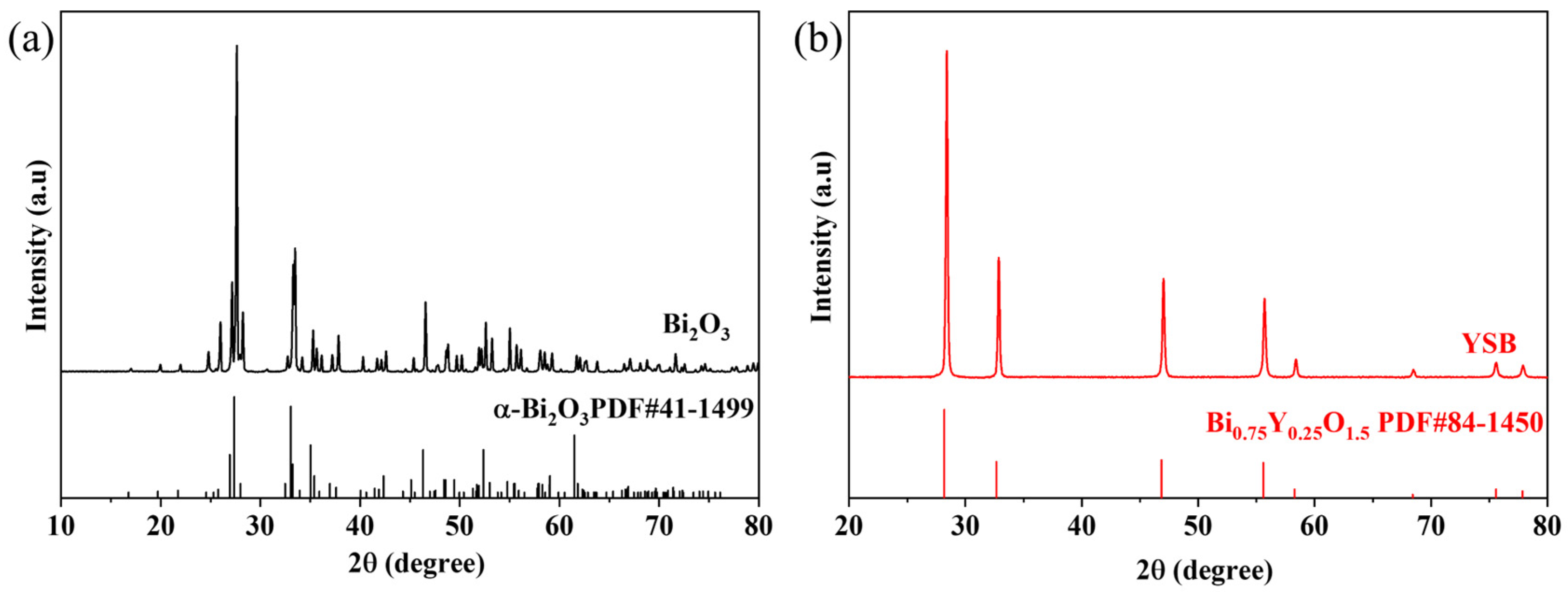
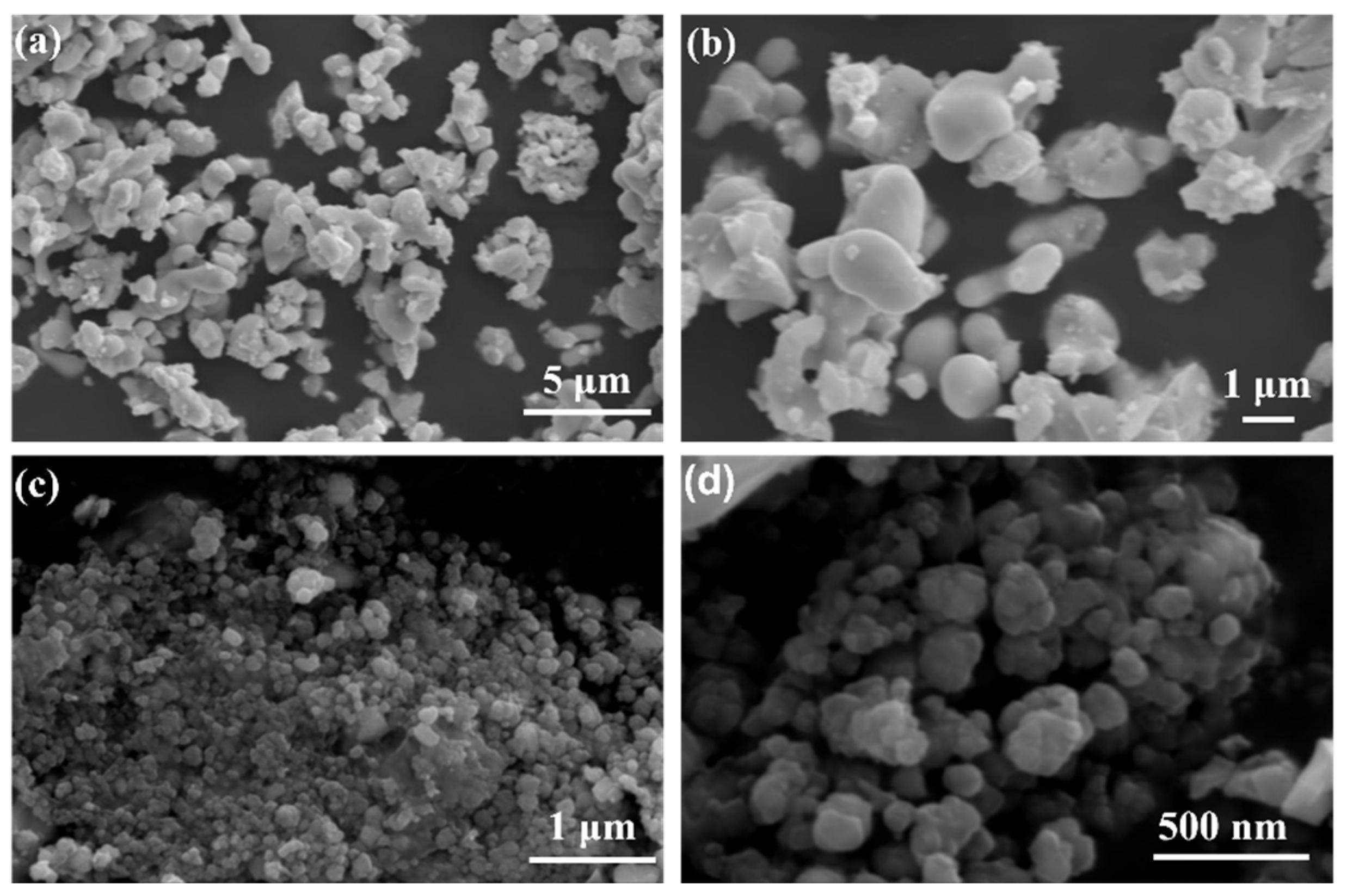
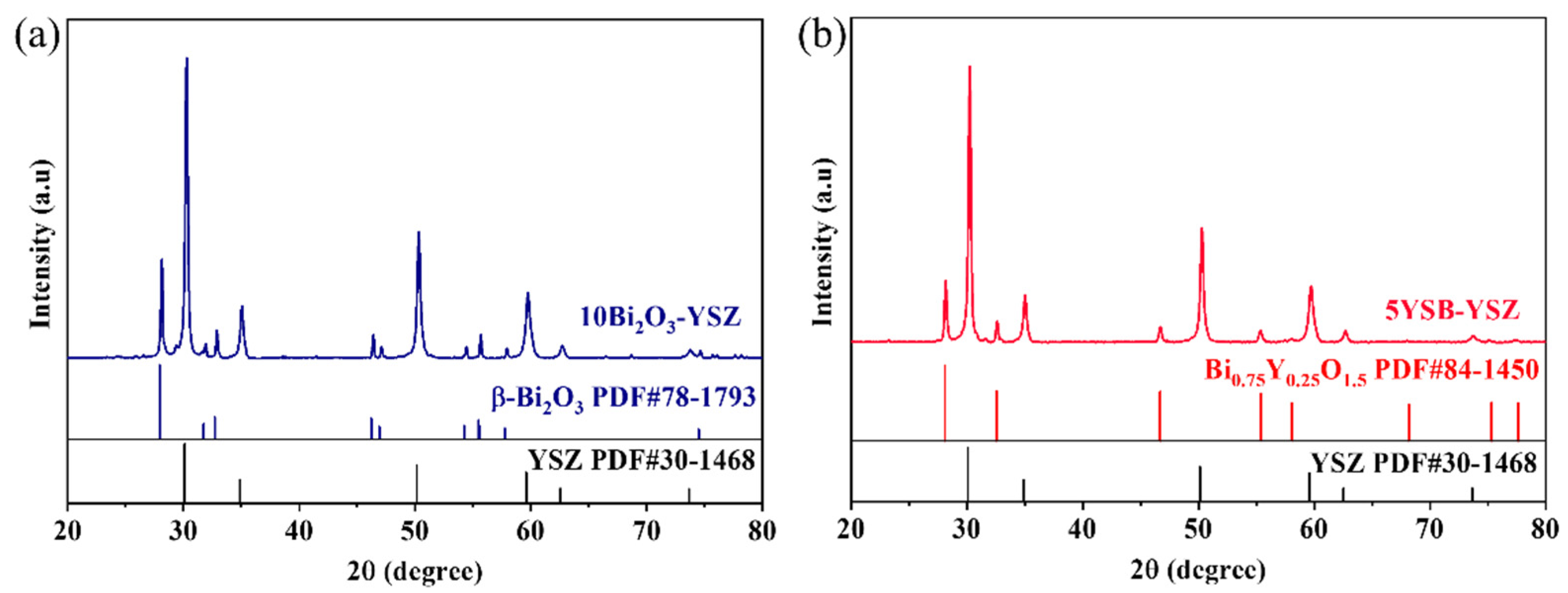
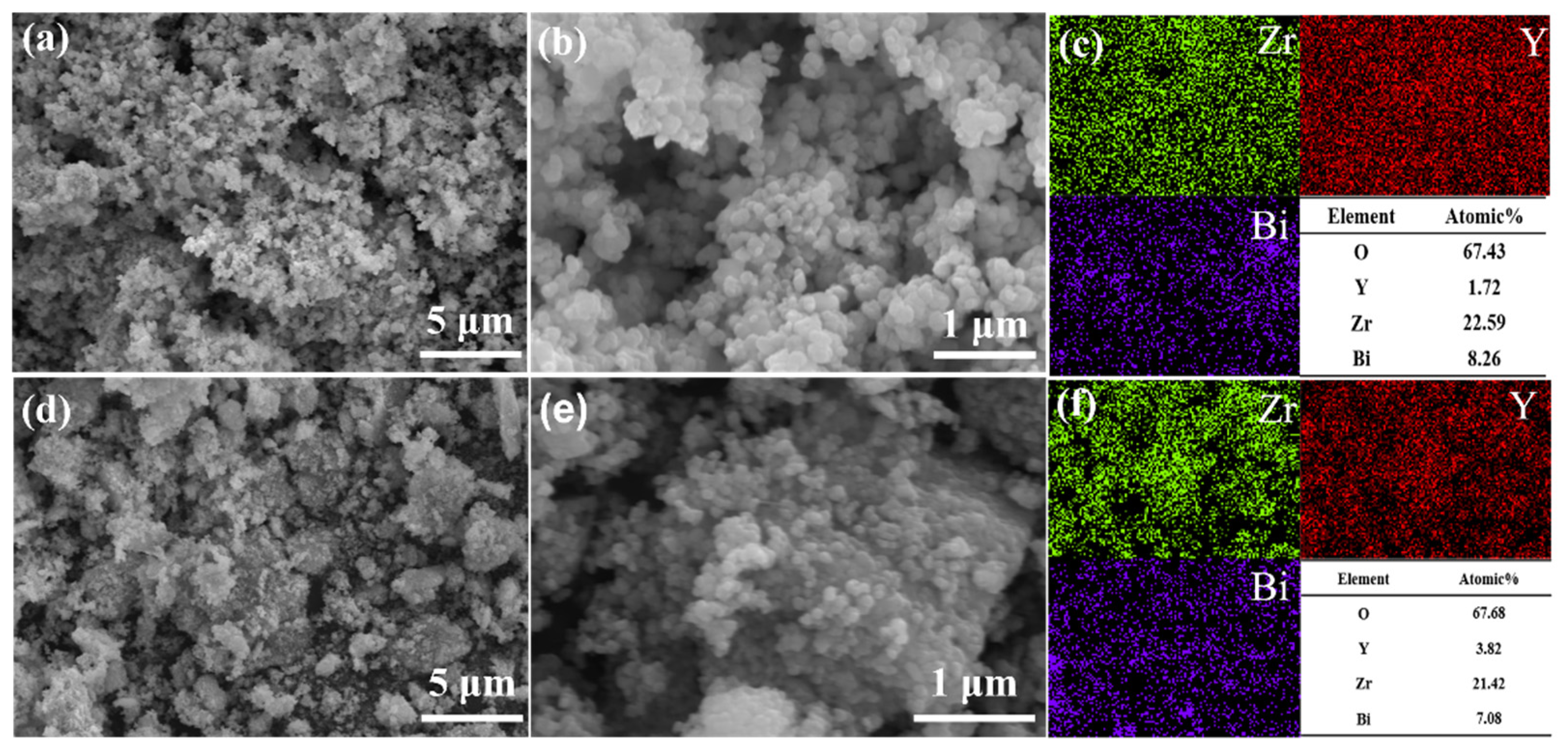
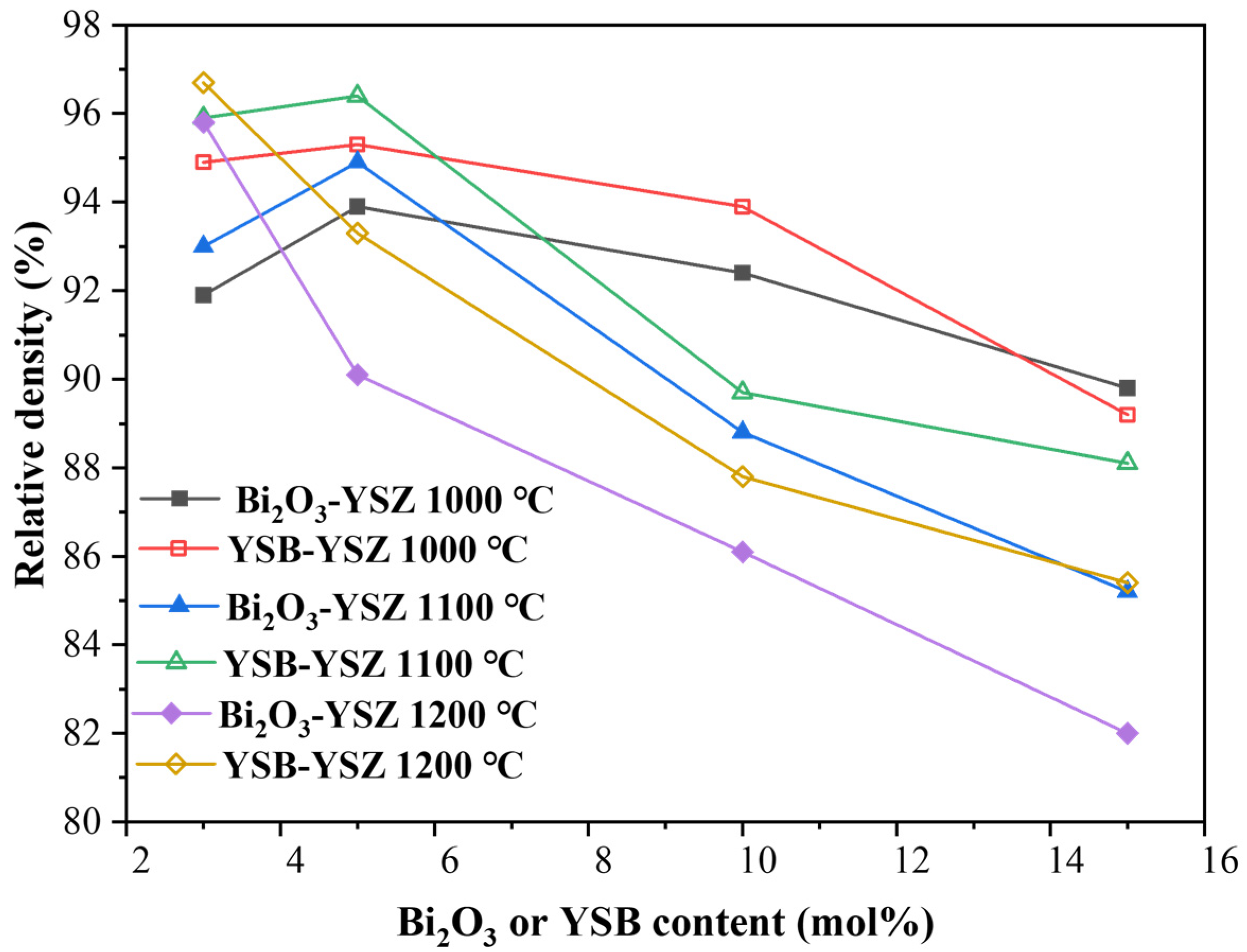
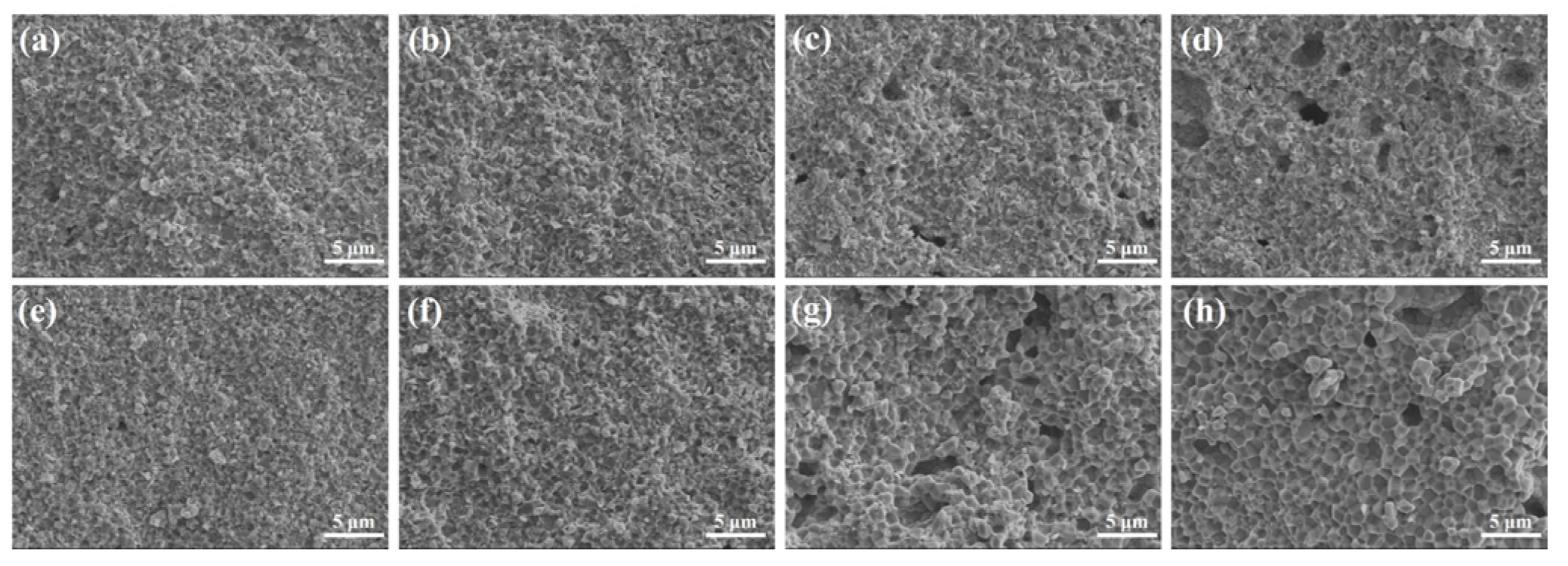




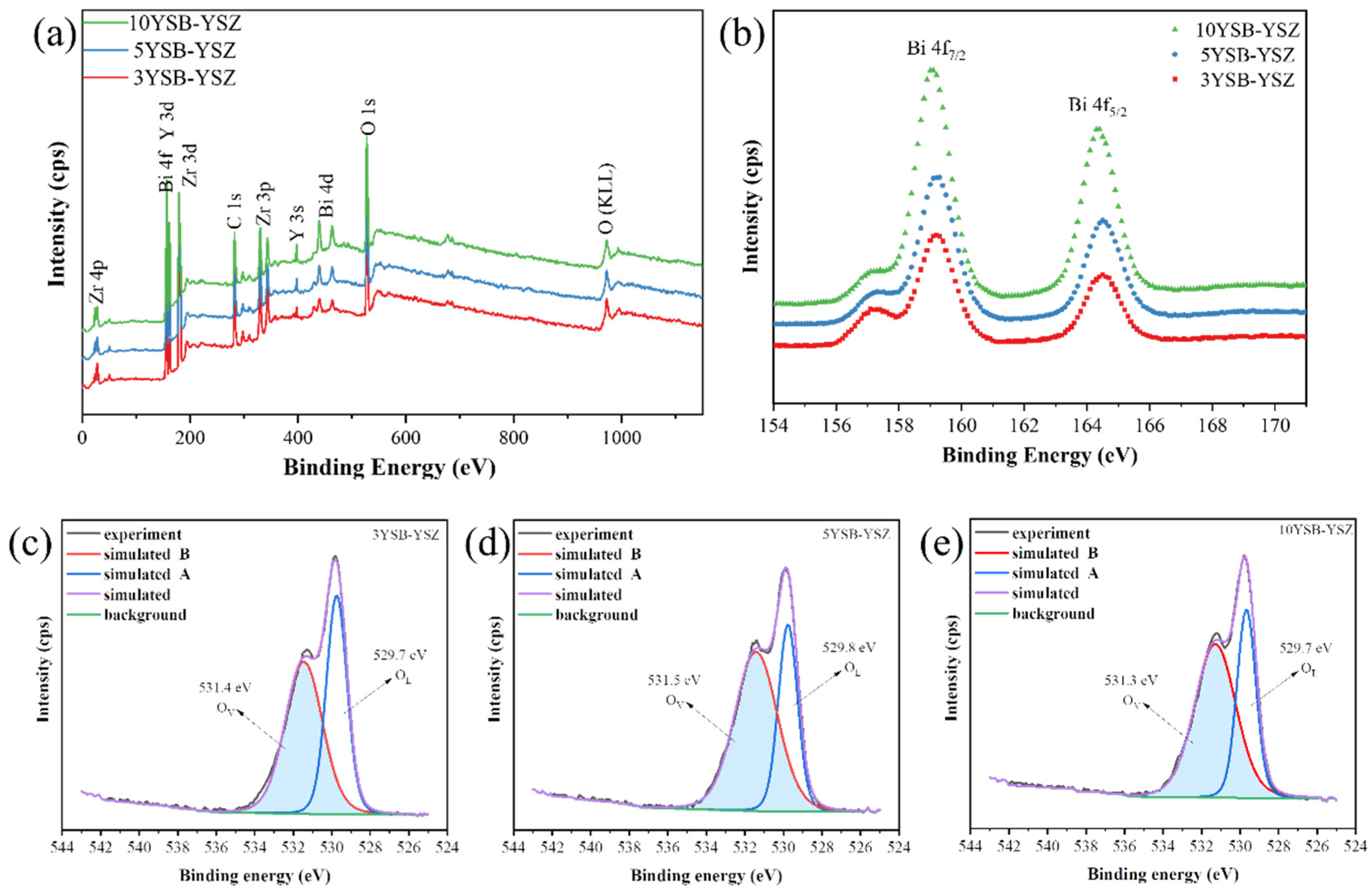
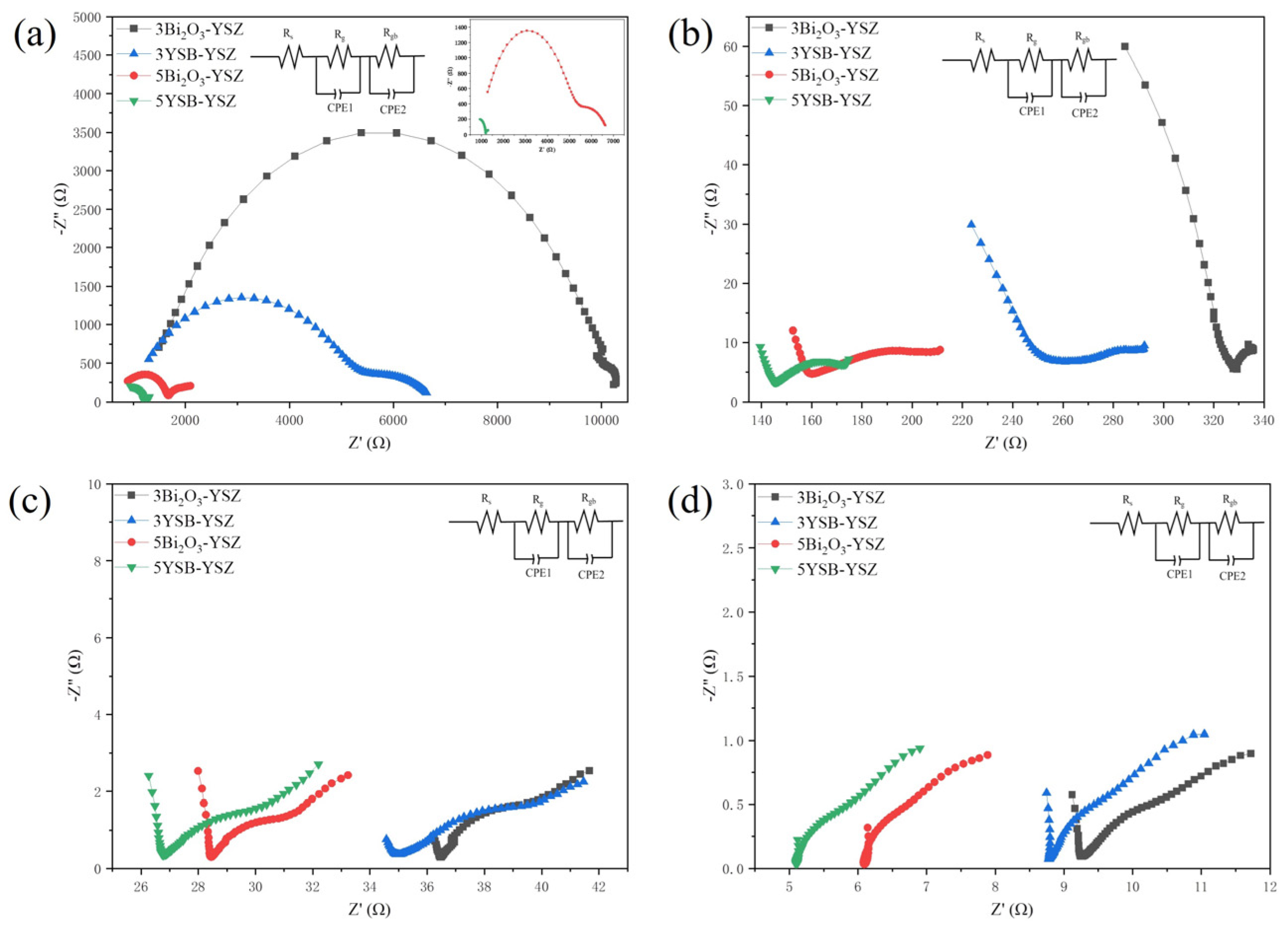
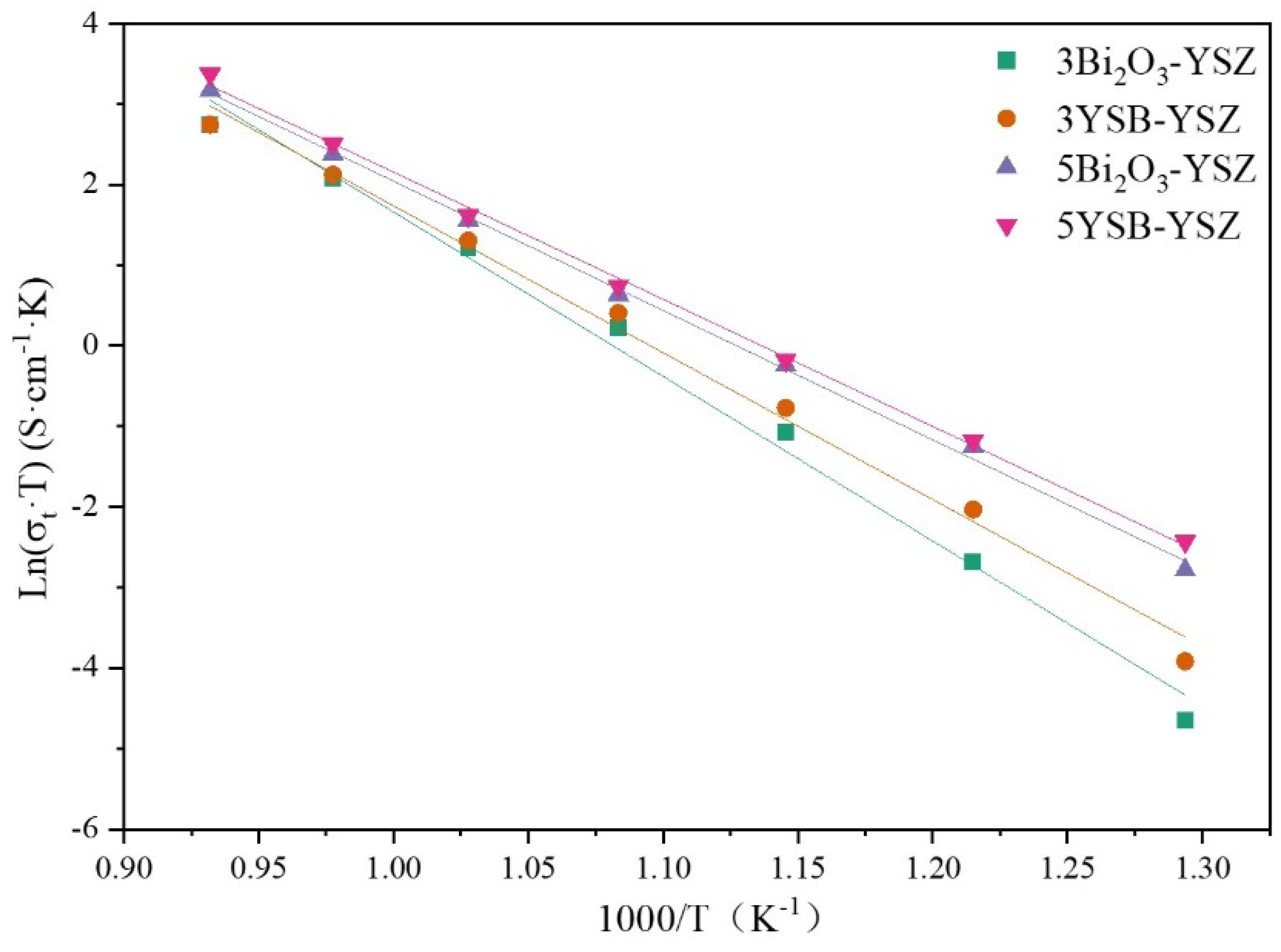
| Sintering Temperature | Bi2O3 Content (mol%) | m-ZrO2 Content in Bi2O3–YSZ (wt%) | m-ZrO2 Content in YSB–YSZ (wt%) |
|---|---|---|---|
| 1000 °C | 3 | 9.8 | 5.3 |
| 5 | 11.5 | 3.7 | |
| 10 | 12.7 | 3.0 | |
| 15 | 15.5 | 0 | |
| 1100 °C | 3 | 9.7 | 6.3 |
| 5 | 10.7 | 4.0 | |
| 10 | 11.9 | 0 | |
| 15 | 14.6 | 0 | |
| 1200 °C | 5 | 6.7 | 1.7 |
| 10 | 7.5 | 0 | |
| 15 | 7.6 | 0 |
| Sample | Type of Oxygen # | Binding Energy (eV) | Peak Area Percentage (%) |
|---|---|---|---|
| 3YSB–YSZ | Ov | 531.4 | 55.76 |
| OL | 529.7 | 44.24 | |
| 5YSB–YSZ | Ov | 531.5 | 64.9 |
| OL | 529.8 | 35.1 | |
| 10YSB–YSZ | Ov | 531.3 | 63.72 |
| OL | 529.7 | 36.28 |
| Composition | Ionic Conductivity (at 800 °C) (S·cm−1) |
|---|---|
| YSZ | 0.0028 [42] |
| 3Bi2O3–YSZ | 0.013 |
| 3YSB–YSZ | 0.014 |
| 5Bi2O3–YSZ | 0.022 |
| 5YSB–YSZ | 0.027 |
Disclaimer/Publisher’s Note: The statements, opinions and data contained in all publications are solely those of the individual author(s) and contributor(s) and not of MDPI and/or the editor(s). MDPI and/or the editor(s) disclaim responsibility for any injury to people or property resulting from any ideas, methods, instructions or products referred to in the content. |
© 2023 by the authors. Licensee MDPI, Basel, Switzerland. This article is an open access article distributed under the terms and conditions of the Creative Commons Attribution (CC BY) license (https://creativecommons.org/licenses/by/4.0/).
Share and Cite
Liu, S.; Zhang, J.; Tian, Y.; Sun, J.; Huang, P.; Li, J.; Han, G. Preparation of Bi2O3–YSZ and YSB–YSZ Composite Powders by a Microemulsion Method and Their Performance as Electrolytes in a Solid Oxide Fuel Cell. Materials 2023, 16, 4673. https://doi.org/10.3390/ma16134673
Liu S, Zhang J, Tian Y, Sun J, Huang P, Li J, Han G. Preparation of Bi2O3–YSZ and YSB–YSZ Composite Powders by a Microemulsion Method and Their Performance as Electrolytes in a Solid Oxide Fuel Cell. Materials. 2023; 16(13):4673. https://doi.org/10.3390/ma16134673
Chicago/Turabian StyleLiu, Shuangshuang, Jingde Zhang, Yuhang Tian, Jian Sun, Panxin Huang, Jianzhang Li, and Guifang Han. 2023. "Preparation of Bi2O3–YSZ and YSB–YSZ Composite Powders by a Microemulsion Method and Their Performance as Electrolytes in a Solid Oxide Fuel Cell" Materials 16, no. 13: 4673. https://doi.org/10.3390/ma16134673





